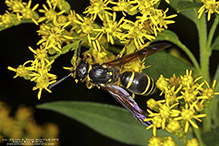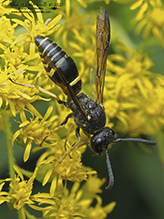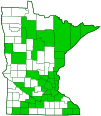lobed mason wasp
(Ancistrocerus capra)
Conservation • Description • Habitat • Ecology • Distribution • Taxonomy
|
|
||||||||||||||
Description |
Lobed mason wasp is a medium-sized stinging wasp. In the United States it occurs in the east from Maine to North Carolina, west to Minnesota and Missouri, in the west from Washington to northern Idaho, and in Colorado. There are just a few scattered records outside of these areas. It is common in Minnesota. Adults are black with yellow markings. The front part of the body (mesosoma) is connected to the rear part (metasoma) by a narrow waist (petiole). Wasp size is often given in terms of the length of the forewing. The female has a 5⁄16″ to ½″ (8.0 to 12.5 mm) forewing length. The head is black. There are two large compound eyes, one on each side of the head, and three small simple eyes (ocelli) in a triangular pattern at the top of the head between the compound eyes. The inner margin of each compound eye is notched. The antennae are thread-like and have 13 segments, including a long first segment (scape) at the base, a short second segment (pedicel), and a whip-like section (flagellum) with 11 segments (flagellomeres). The upper side of all antennal segments is black. The underside of the scape is yellow, forming a continuous stripe that is not narrowed in the middle. The underside of the pedicel and each flagellum is yellowish. The last flagellum is not hooked at the tip. The jaws (mandibles) are long and knife-like. The plate on the face (clypeus) is black with a yellow spot on each lateral margin and a pair of yellow spots on the lower margin. There is a yellow spot on the head between the antennae bases, and a small yellow spot (postocular spot) behind each compound eye. The thorax is black and has three segments, the prothorax, mesothorax, and metathorax. However, the first segment of the abdomen (propodeum) is fused to the thorax, giving the thorax the appearance of having four segments. The upper plate on the prothorax (pronotum) is short and collar-like. It does not have a narrow transverse ridge (carina) on the front margin. It extends rearward on the sides to the plate at the base of each wing (tegula). It appears horseshoe-shaped when viewed from above, triangular when viewed from the side. It is mostly black except for a yellow band on the front margin of the upper (dorsal) surface. The band tapers narrowly to each side, narrows toward the middle, and is sometimes narrowly interrupted in the middle. On the mesothorax, the large front plate (mesoscutum or scutum) has a pair of distinct longitudinal grooves that effectively divide it into a central portion and two lateral lobes. This is the feature that gives the wasp its common name. The smaller rear plate (scutellum) has a pair of small yellow spots. The spots are variable, usually small, round, and widely separated, sometimes rectangular and narrowly separated. The upper surface of the metathorax (metanotum) is entirely black, with no yellow markings. The propodeum is shiny has two very prominent lateral ridges. There is a small yellow spot at the base of each forewing and a larger yellow spot on the side of the thorax below the wing bases. The first and second abdominal segments form a petiole that connect the abdomen to the thorax. The upper part of the first segment of the metasoma (first tergite) is wider than long and only half as long as the second tergite. It is black with a yellow band at the rear. The second tergite has a broad yellow band at the rear and is almost as long as the remaining tergites combined. There is always a yellow band on at least the first through fourth tergites. The wings are moderately tinted smoky brown and have dark veins. They are folded longitudinally over the body when at rest. On the forewing, the first discoidal cell is very long, about half the total length of the wing. There are three submarginal cells. The legs are black and yellow. The first segment (trochanter) is not divided – it has just one segment. On each leg the third segment (femur) is mostly black, yellow just at the tip, and the fourth segment (tibia) is yellow above, black below. The tibiae on the middle leg has a single spur at the tip. The last part of each leg (tarsus), corresponding to the foot, has five segments. There is a pair of claws at the tip of each tarsus. The claws are split (cleft) at the end. The male is smaller, with a ¼″ to ⅜″ (7.0 to 10.0 mm) forewing length. The antennae have just 12 segments. The last flagellum is hooked at the tip. The spot between the antennae bases is smaller. The clypeus is entirely yellow. The postocular spot is sometimes very small. The spots on the scutum are smaller and are sometimes missing. The abdomen has seven visible segments. There is a yellow band on tergites one through six. |
Size |
Female forewing length: 5⁄16″ to ½″ (8.0 to 12.5 mm) Male forewing length: ¼″ to ⅜″ (7.0 to 10.0 mm) |
Similar Species |
Habitat |
|
Ecology |
Season |
Possibly two generations per year: Early June to early September (CCESR and BugGuide) |
Behavior |
The wings are folded longitudinally over the body when at rest. |
Life Cycle |
The female nests in a preexisting cavity, which could be a boring in wood, a hollow sumac or elderberry twig, or an abandoned mud dauber nest. The nest has multiple cells separated by a partition made of mud. |
Larva Food |
Caterpillars |
Adult Food |
|
Distribution |
||
|
Sources |
|
| 9/1/2024 | ||
Occurrence |
||
Common |
||
Taxonomy |
|
Order |
Hymenoptera (Ants, Bees, Wasps, and Sawflies) |
Suborder |
Apocrita (Narrow-waisted Wasps, Ants, and Bees) |
No Rank |
Aculeata (ants, bees, and stinging wasps) |
Superfamily |
Vespoidea (vespoid wasps) |
Family |
Vespidae (hornets, paper wasps, potter wasps, and allies) |
Subfamily |
|
Genus |
|
This North American species was originally described as Ancistrocerus capra by de Saussure in 1857. When he described it, he noted its close relationship to the European species Ancistrocerus antilope. Bequaert confirmed the close relationship in 1925, and in 1944 he synonymized them. That synonomy was generally accepted, and by 1955 the species was known as Ancistrocerus antilope in both Europe and North America. A recently published journal article (Fateryga et al., 2023) contended that the two species should be separated based on differences on the structure of the facial plate (clypeus) and the male genetalia. The original name of the North American species was resurrected, and it is once again known as Ancistrocerus capra. |
|
Subordinate Taxa |
|
|
|
Synonyms |
|
|
|
Common Names |
|
lobed mason wasp |
|
Glossary
Clypeus
On insects, a hardened plate on the face above the upper lip (labrum).
Femur
On insects and arachnids, the third, largest, most robust segment of the leg, coming immediately before the tibia. On humans, the thigh bone.
Flagellomere
A segment of the whip-like third section of an insect antenna (flagellum).
Mesosoma
In Hymenoptera: the front part of the body, consisting of all three segments of the thorax and the first segment of the abdomen, to which the wings are attached.
Metasoma
In Hymenoptera: the armored rear part of the body, consisting of the second segment of the abdomen and all segments posterior to it.
Ocellus
Simple eye; an eye with a single lens. Plural: ocelli.
Pedicel
On plants: the stalk of a single flower in a cluster of flowers. On insects: the second segment of the antennae. On Hymenoptera and Araneae: the narrow stalk connecting the thorax to the abdomen: the preferred term is petiole.
Petiole
On plants: The stalk of a leaf blade or a compound leaf that attaches it to the stem. On ants and wasps: The constricted first one or two segments of the rear part of the body.
Pronotum
The exoskeletal plate on the upper side of the first segment of the thorax of an insect.
Propodeum
In Hymenoptera: the last segment of the thorax, anatomically the first segment of the abdomen.
Scape
In plants: An erect, leafless stalk growing from the rootstock and supporting a flower or a flower cluster. In insects: The basal segment of the antenna.
Tarsus
On insects, the last two to five subdivisions of the leg, attached to the tibia; the foot. On spiders, the last segment of the leg. Plural: tarsi.
Tegula
A small, hardened, plate, scale, or flap-like structure that overlaps the base of the forewing of insects in the orders Lepidoptera, Hymenoptera, Diptera, and Homoptera. Plural: tegulae.
Tergite
The upper (dorsal), hardened plate on a segment of the thorax or abdomen of an arthropod or myriapod.
Tibia
The fourth segment of an insect leg, after the femur and before the tarsus (foot). The fifth segment of a spider leg or palp. Plural: tibiae.
Visitor Photos |
||
Share your photo of this insect. |
||
This button not working for you? |
||
Bobbi Johnson |
||
 |
 |
|
… from the garden |
||
Alfredo Colon |
||
 |
 |
|
MinnesotaSeasons.com Photos |
||
|
||
|
||

Slideshows |
|

Visitor Videos |
||
Share your video of this insect. |
||
This button not working for you? |
||
|
Other Videos |
||
Potter Wasp (Ancistrocerus antilope) |
About
May 22, 2010 A potter wasp busily making a home between the bricks of my house. The wet part you see there was constructed in only about 1/2 hour. Busy little female. |
Mason Wasp (Vespidae: Ancistrocerus antilope?) Male on Blossom |
About
Aug 8, 2010 Photographed at Itasca State Park, Minnesota (06 August 2010). |

Visitor Sightings |
||
Report a sighting of this insect. |
||
This button not working for you? |
||
Bobbi Johnson |
Location: Silver Bay, MN … from the garden |
 |
| Alfredo Colon 8/11/2022 |
Location: Albany, NY |
 |
| Alfredo Colon 8/20/2019 |
Location: Woodbury, MN |
 |
MinnesotaSeasons.com Sightings |
||
|

Created: 3/1/2023 Last Updated: © MinnesotaSeasons.com. All rights reserved. |
